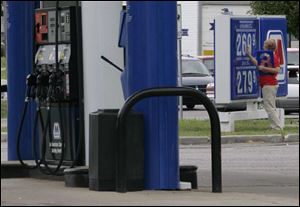
High gasoline prices could fuel prioritizing
8/16/2005The bitter pill may be the one that works best.
It's hard to swallow the current gasoline prices - $2.69 a gallon or more at many area stations yesterday.
But some good may come from this bitter medicine. If fuel prices keep rising, consumers will be forced to consider alternatives, perhaps re-evaluate priorities, and make amends for their errant ways.
This nasty opportunity to prioritize is similar to others in the past. When medical costs and health insurance premiums began rising sharply, millions of Americans had to consider not just how to pay the higher prices but also how to avoid being unhealthy. Many started looking at their diets, their exercise programs, and their habits.
When housing costs soared in many cities, residents took hard looks at their needs. How large a home does a family really need, especially as children approach adulthood? Does it make sense to own a home in a market where real-estate taxes can become ruinous?

With gasoline at $2.69 a gallon, its cost becomes a noticeable factor in deciding whether a trip is necessary.
So now it's our turn with gasoline and cars.
The United States has had several chances to mend its energy-wasting ways - notably in the 1970s, marked by two energy crises. But, of course, very little actually happened.
Energy conservation didn't take hold, and Congress failed to do anything meaningful, such as adopt a realistic federal gasoline tax that could have paid for public-transportation and alternative-energy programs.
During the 2005 energy crisis, Congress once again did the easy thing: The new energy bill is a boon to big oil companies but does little to encourage conservation, at least in the near future.
We're going to have to do this on our own. Gasoline prices have our full attention, and consumers will start taking action, probably pretty soon if the price gets close to $3 a gallon. For example, let's say you frequent a favorite restaurant 25 or 30 miles from town. A $50 dinner for two suddenly became a $55 dinner.
To be fair, gasoline has always been a part of the equation, but it never seemed worth tallying when it cost $1 a gallon, or even $2 a gallon. But at $2.50 or more, it becomes a much more noticeable factor.
While we're looking at the high cost of gasoline, maybe we'll also look at where else the money is going. Maybe we need to economize all the way around. How often do we really need to drive out of town for dinner?
Commuters will be doing the same kind of math. A daily round trip on the bus is starting to look a lot better than driving and paying for parking. Car-pooling is starting to look attractive too.
Shopping is another area to look at. The days of driving across town to save a couple of bucks on groceries are over. Perhaps this is an opportunity to scrutinize the grocery bill, too. How much waste is hidden there?
For that matter, how much waste is hidden in our overall budgets? What do we spend too much money on? Vacations? Entertainment? Cars?
The latest energy crisis got our attention in a hurry. Actually, the difference between gas at $1.99 a gallon and $2.69 a gallon is only 28 percent, but it seems a lot more when you're filling a tank.
Some experts have gloom-and-doom predictions, including a recession as a result of high oil prices.
Perhaps that will happen, but even that dark cloud has a silver lining: A recession would make it less likely that the Federal Reserve will continue its interest-rate increases.
The trade-off could be we pay more for gas now, less for borrowing later.
But in any case, the overriding message is loud and clear: Consume less - of everything. Slow down a bit. Enjoy life closer to home. Buy sensible cars. Spend rationally. Live within our means. The high price of gasoline may be a blessing in disguise.